
The Southern Alps is a mountain range extending along much of the length of New Zealand's South Island, reaching its greatest elevations near the range's western side. The name "Southern Alps" generally refers to the entire range, although separate names are given to many of the smaller ranges that form part of it.

Nothofagus, also known as the southern beeches, is a genus of 43 species of trees and shrubs native to the Southern Hemisphere in southern South America and east and southeast Australia, New Zealand, New Guinea, and New Caledonia. The species are ecological dominants in many temperate forests in these regions. Some species are reportedly naturalised in Germany and Great Britain. The genus has a rich fossil record of leaves, cupules, and pollen, with fossils extending into the late Cretaceous period and occurring in Australia, New Zealand, Antarctica, and South America.
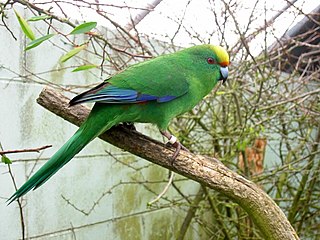
Cyanoramphus malherbi, usually known as the orange-fronted parakeet in New Zealand or Malherbe's parakeet internationally, is a small parrot endemic to New Zealand. In New Zealand it is always known as the orange-fronted parakeet, a name it shares with a species from Central America, while in the rest of the world it is known as Malherbe's parakeet. Restricted to a few valleys in the South Island and four offshore islands, its population declined to around 200 in the 1990s, and it is considered critically endangered.

Nothofagus fusca, commonly known as red beech is a species of southern beech, endemic to New Zealand, where it occurs on both the North Island and South Island. Generally it is found on lower hills and inland valley floors where soil is fertile and well drained. In New Zealand the species is called Fuscospora fusca.

Nothofagus menziesii, commonly known as silver beech, is a tree of the southern beech family endemic to New Zealand. Its common name probably comes from the fact that its bark is whitish in colour, particularly in younger specimens. It is found from Thames southwards in the North Island, and throughout the South Island. Silver beech is a forest tree up to 30 m tall. The trunk, which is often buttressed, may be up to 2 m in diameter. The leaves are small, thick and almost round in shape, 6 to 15 mm long and 5 to 15 mm wide with rounded teeth which usually occur in pairs, 1 or 2 hair fringed domatia are found on the underside of each leaf. Its Māori name is tawhai. It grows from low altitudes to the mountains. Nothofagus menziesii was proposed to be renamed Lophozonia menziesii in 2013.

Leucopogon fasciculatus, the tall mingimingi, is a species of shrub within the family Ericaceae. It is endemic to New Zealand. This species is found in the North Island north of the Bay of Plenty and Taranaki. In the South Island it is found in north west Nelson. It is present in the red and silver beech forests admixed with rimu and miro podocarps on northern South Island.
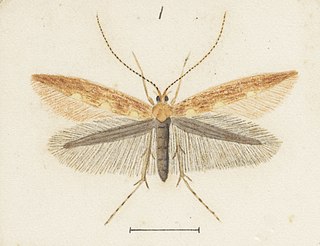
Caloptilia selenitis is a moth of the family Gracillariidae. It is known from New Zealand.
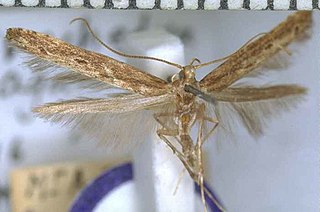
Batrachedra agaura is a species of moth in the family Batrachedridae. It is endemic to New Zealand. This species is distributed throughout the country. The species inhabits native forest especially beech and kanuka forest or manuka scrubland. The larvae of this species is associated with sooty mold and with sooty beech scale. It has been hypothesised that the larvae feed on sooty beech scale. However they may also feed on the sooty mold itself. The adult female is lighter in appearance than the male and the species shows considerable variation in patterns on forewing. Adults are on the wing from October to February. They are nocturnal and occasionally attracted to light.

Heterocrossa eriphylla, also known as the lichen snoutlet moth, is a species of moth in the family Carposinidae. It is endemic to New Zealand. The larvae of this species feed on the healing wounds of New Zealand beech trees.

Isonomeutis amauropa is a species of moth in the Copromorphidae family. It is endemic to New Zealand where it can be found on both the North and South Islands. I. amauropa inhabits native forest particularly forest dominated by Rimu and native beech trees. The larvae of this species consumes margarodid scale insects that live under the bark of these trees. When mature the larvae pupate in a cocoon made of silk and covered in twigs and frass. This cocoon is normally placed under the bark of the same tree the larvae inhabited. Adults of I. amauropa are on the wing from September to February.

Mnesarchaea fallax is a species of primitive moth in the family Mnesarchaeidae. It is endemic to New Zealand. This species is found in the Taranaki, Taupo, Nelson and Buller regions. It lives in a variety of habitats such as beech forest clearings, native podocarp forest, red tussock grasslands as well as in flax wetlands and at higher altitudes of up to 1300m. Much of the life history of this species is unknown and as at 2021 the host plants of this species have yet to be confirmed. The adult moths are on the wing from October to December. This species is classified as "Not Threatened" by the Department of Conservation.

Nothofagus cliffortioides, commonly called mountain beech, is a species of Southern beech tree and is endemic to New Zealand. Mountain beech grows in mountainous regions at high elevations. In New Zealand the taxon is called Fuscospora cliffortioides. Nothofagus cliffortioides occupies a wider range of habitat than any other New Zealand tree species and it shows a corresponding range of life form, seeding habits, regenerative patterns, growth habits, growth rates, stand replacement and mortality patterns.

Victoria Forest Park, is situated on the West Coast of the South Island of New Zealand. At 2,069 square kilometres (799 sq mi) it is New Zealand's largest forest park. The park is administered by the Department of Conservation (DOC).

Epichorista emphanes, the beech leafroller, is a species of moth of the family Tortricidae. It is found in New Zealand.
Austramathes coelacantha is a species of moth in the family Noctuidae. It is endemic to New Zealand and is found in the central and east of the South Island. It lives in shrubland in inland areas as well as in Southern beech forest at subalpine altitudes. The life history of this species is unknown as are the host species of its larvae. However the larval host-plants may be species within the genus of Melicytus. Adult moths are on the wing during the months of January to March. They are attracted to light and appear to be active later in the evening, and not at twilight.

Proteodes carnifex is a species of moth in the family Depressariidae. It is endemic to New Zealand. Both the larvae and the adults of this species are variable in appearance. However the adults are normally easily identified as the outline is characteristic and the size is consistent. In appearance, adult moths mimic the leaves of their larval host plants. This species has been found near Wellington in the North Island, the tableland of Mount Arthur, in the Canterbury region, Arthur's Pass and at Lake Wakatipu in the South Island. The larval hosts of this species are southern beech trees, particularly black beech and mountain beech but larvae have also been found on Nothofagus fusca, Nothofagus truncata and Nothofagus menziesii. The female moth deposits her eggs individually on the underside of native beech tree leaves. Once hatched the larvae feed on those leaves through winter and spring and then pupate in January. The adult moth emerges from the pupa after fourteen days and is on the wing from January until April. They are day flying moths and are not attracted to light. Various insects parasitise the larvae of this moth including several species of wasp as well as flies including the endemic fly, Pales funesta.
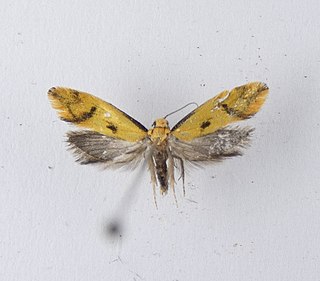
Tingena actinias is a species of moth in the family Oecophoridae. It is endemic to New Zealand and is found on the North and South Islands. The larvae of this species are leaf litter feeders. The preferred habitat of this species is shrubland and it has also been observed in gumland heaths and in beech forest.

Tingena apertella is a species of moth in the family Oecophoridae. It is endemic to New Zealand and can be found in both the North and South Islands. Adults are on the wing from November to January and the species is common in beech forests at approximately 2000 ft. At rest on the ground this species appears very similar to a yellow beech leaf.

Tingena monodonta is a species of moth in the family Oecophoridae. It is endemic to New Zealand and has been found in both the North and South Islands. This species inhabits native beech forest at altitudes of between 2500 - 3000 ft. The adults of the species are on the wing from November and December.
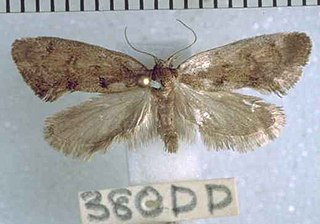
Tingena ombrodella is a species of moth in the family Oecophoridae. It is endemic to New Zealand and has been observed in the North and South Islands. Adults of this species are on the wing from November to January and the larvae of the species are litter feeders. This species has been found to inhabit native beech forest.


















